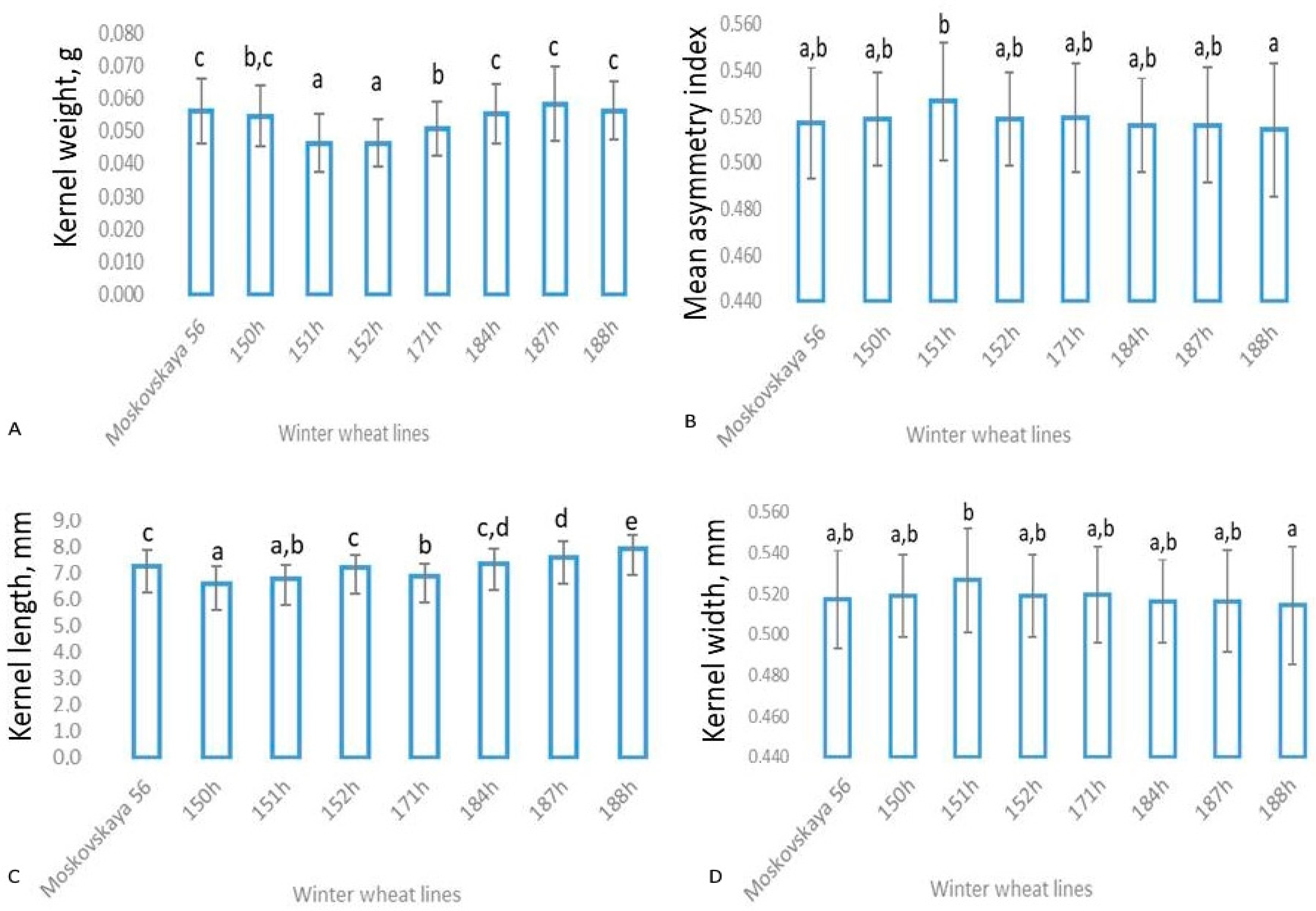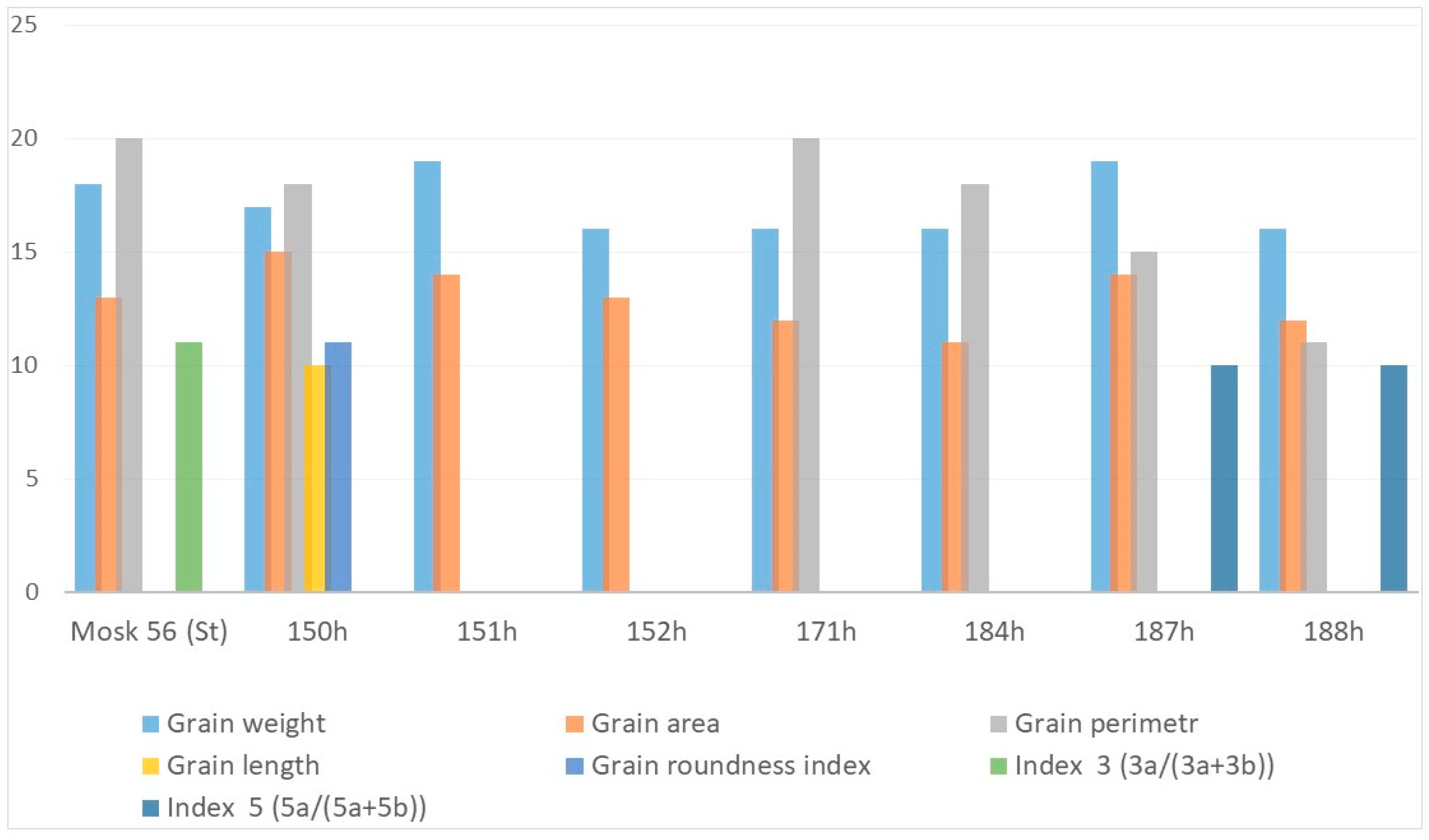Can Kernel Uniformity Indices Be Used as Criteria for Variability Assessment of Wheat Breeding Lines?
Abstract
1. Introduction
2. Materials and Methods
2.1. Agrotechnical Conditions
2.2. Plant Material
2.3. Assessment of Material for Analysis
2.4. Statistical Analysis
3. Results
4. Discussion
5. Conclusions
Supplementary Materials
Author Contributions
Funding
Institutional Review Board Statement
Informed Consent Statement
Data Availability Statement
Conflicts of Interest
References
- FAO. Food Outlook—Biannual Report on Global Food Markets; FAO: Rome, Italy, 2024. [Google Scholar] [CrossRef]
- Guo, J.; Mao, K.; Yuan, Z.; Qin, Z.; Xu, T.; Bateni, S.M.; Zhao, Y.; Ye, C. Global food security assessment during 1961–2019. Sustainability 2021, 13, 14005. [Google Scholar] [CrossRef]
- Grote, U.; Fasse, A.; Nguyen, T.T.; Erenstein, O. Food security and dynamics of wheat and maize value chains in Africa and Asia. Front. Sustain. Food Syst. 2021, 4, 617009. [Google Scholar] [CrossRef]
- Chand, R. Challenges to ensuring food security through wheat. CABI Rev. 2009, 4, 1–13. [Google Scholar] [CrossRef]
- Long, S.P.; Ort, D.R. More than taking the heat: Crops and global change. Curr. Opin. Plant Biol. 2010, 13, 240–247. [Google Scholar] [CrossRef] [PubMed]
- Taghizadeh-Alisaraei, A.; Tatari, A.; Khanali, M.; Keshavarzi, M. Potential of biofuels production from wheat straw biomass, current achievements and perspectives: A review. Biofuels 2023, 14, 79–92. [Google Scholar] [CrossRef]
- Wang, H.; He, Y.; Qian, B.; McConkey, B.; Cutforth, H.; McCaig, T.; Hoogenboom, G.; McLeod, G.; Zentner, R.; DePauw, R.; et al. Climate change and biofuel wheat: A case study of southern Saskatchewan. Can. J. Plant Sci. 2012, 92, 421–425. [Google Scholar] [CrossRef]
- Yadav, M.R.; Choudhary, M.; Singh, J.; Lal, M.K.; Jha, P.K.; Udawat, P.; Gupta, N.K.; Rajput, V.D.; Garg, N.K.; Maheshwari, C.; et al. Impacts, tolerance, adaptation, and mitigation of heat stress on wheat under changing climates. Int. J. Mol. Sci. 2022, 23, 2838. [Google Scholar] [CrossRef]
- Hossain, A.; Skalicky, M.; Brestic, M.; Maitra, S.; Ashraful, A.M.; Syed, M.A.; Islam, T. Consequences and mitigation strategies of abiotic stresses in wheat (Triticum aestivum L.) under the changing climate. Agronomy 2021, 11, 241. [Google Scholar] [CrossRef]
- Li, Y.; Cui, Z.; Ni, Y.; Zheng, M.; Yang, D.; Jin, M.; Chen, J.; Wang, Z.; Yin, Y. Plant density effect on grain number and weight of two winter wheat cultivars at different spikelet and grain positions. PLoS ONE 2016, 11, e0155351. [Google Scholar] [CrossRef] [PubMed]
- Feng, F.; Han, Y.; Wang, S.; Yin, S.; Peng, Z.; Zhou, M.; Gao, W.; Wen, X.; Qin, X.; Siddique, K.H.M. The effect of grain position on genetic improvement of grain number and thousand grain weight in winter wheat in north China. Front. Plant Sci. 2018, 9, 129. [Google Scholar] [CrossRef] [PubMed]
- Ferrante, A.; Savin, R.; Slafer, G.A. Relationship between fruiting efficiency and grain weight in durum wheat. Field Crops Res. 2015, 177, 109–116. [Google Scholar] [CrossRef]
- Philipp, N.; Weichert, H.; Bohra, U.; Weschke, W.; Schulthess, A.W.; Weber, H. Grain number and grain yield distribution along the spike remain stable despite breeding for high yield in winter wheat. PLoS ONE 2018, 13, e0205452. [Google Scholar] [CrossRef] [PubMed]
- Boz, H.; Gercekaslan, K.E.; Karaoglu, M.M.; Kotancilar, H.I.G. Differences in some physical and chemical properties of wheat grains from different parts within the spike. Turk. J. Agric. For. 2012, 36, 309–316. [Google Scholar] [CrossRef]
- Li, H.S.; Cao, X.Y.; Song, J.M.; Liu, P.; Cheng, D.G.; Liu, A.F.; Wang, C.G.; Liu, J.J.; Sun, Z.J. Effects of spikelet and grain positions on grain weight and protein content of different wheat varieties. Acta Agron. Sin. 2017, 43, 238–252. (In Chinese) [Google Scholar] [CrossRef]
- Slavin, J.; Tucker, M.; Harriman, C.; Jonnalagadda, S.S. Whole grains: Definition, dietary recommendations, and health benefits. Cereal Foods World 2013, 58, 191–198. [Google Scholar] [CrossRef]
- Abdipour, M.; Ebrahimi, M.; Izadi-Darbandi, A.; Mastrangelo, A.M.; Najafian, G.; Arshad, Y.; Mirniyam, G. Association between grain size and shape and quality traits, and path analysis of thousand grain weight in Iranian bread wheat landraces from different geographic regions. Not. Bot. Horti Agrobot. Cluj-Napoca 2016, 44, 228–236. [Google Scholar] [CrossRef][Green Version]
- Armstrong, B.G.; Weiss, M.; Grieg, R.I.; Dines, J.; Gooden, J.; Aldred, G.P. Determining screening fractions and kernel roundness with digital image analysis. In Proceedings of the 11th Australian Barley Technical Symposium, Glenelg, Australia, 7–10 September 2003. [Google Scholar]
- Louhaichi, M.; Borman, M.M.; Johnson, D.E. Spatially located platform and aerial photography for documentation of grazing impacts on wheat. Geocarto Int. 2001, 16, 65–70. [Google Scholar] [CrossRef]
- Aniskina, T.S.; Baranova, E.N.; Lebedev, S.V.; Reger, N.S.; Besaliev, I.N.; Panfilov, A.A.; Kryuchkova, V.A.; Gulevich, A.A. Unexpected effects of sulfate and sodium chloride application on yield qualitative characteristics and symmetry indicators of hard and soft wheat kernels. Plants 2023, 12, 980. [Google Scholar] [CrossRef]
- Aniskina, T.S.; Sudarikov, K.A.; Levinskikh, M.A.; Gulevich, A.A.; Baranova, E.N. Bread wheat in space flight: Is there a difference in kernel quality? Plants 2023, 13, 73. [Google Scholar] [CrossRef] [PubMed]
- Barbosa, B.D.S.; Ferraz, G.A.S.; Goncalves, L.M.; Marin, D.B.; Maciel, D.T.; Ferraz, P.F.P.; Rossi, G. RGB vegetation indices applied to grass monitoring: A qualitative analysis. Agron. Res. 2019, 17, 349–357. [Google Scholar]
- Gitelson, A.A.; Kaufman, Y.J.; Stark, R.; Rundquist, D. Novel algorithms for remote estimation of vegetation fraction. Remote Sens. Environ. 2002, 80, 76–87. [Google Scholar] [CrossRef]
- Fan, C.; Xing, Y.; Mao, H.; Lu, T.; Han, B.; Xu, C.; Li, X.; Zhang, Q. GS3, a major QTL for grain length and weight and minor QTL for grain width and thickness in rice, encodes a putative transmembrane protein. Theor. Appl. Genet. 2006, 112, 1164–1171. [Google Scholar] [CrossRef]
- Takano-Kai, N.; Jiang, H.; Kubo, T.; Sweeney, M.; Matsumoto, T.; Kanamori, H.; Padhukasahasram, B.; Bustamante, C.; Yoshimura, A.; Doi, K.; et al. Evolutionary history of GS3, a gene conferring grain length in rice. Genetics 2009, 182, 1323–1334. [Google Scholar] [CrossRef]
- Song, X.-J.; Huang, W.; Shi, M.; Zhu, M.-Z.; Lin, H.-X. A QTL for rice grain width and weight encodes a previously unknown RING-type E3 ubiquitin ligase. Nat. Genet. 2007, 39, 623–630. [Google Scholar] [CrossRef] [PubMed]
- Shomura, A.; Izawa, T.; Ebana, K.; Ebitani, T.; Kanegae, H.; Konishi, S.; Yano, M. Deletion in a gene associated with grain size increased yields during rice domestication. Nat. Genet. 2008, 40, 1023–1028. [Google Scholar] [CrossRef] [PubMed]
- Nadolska-Orczyk, A.; Rajchel, I.K.; Orczyk, W.; Gasparis, S. Major genes determining yield-related traits in wheat and barley. Theor. Appl. Genet. 2017, 130, 1081–1098. [Google Scholar] [CrossRef]
- Mangini, G.; Blanco, A.; Nigro, D.; Signorile, M.A.; Simeone, R. Candidate genes and quantitative trait loci for grain yield and seed size in durum wheat. Plants 2021, 10, 312. [Google Scholar] [CrossRef] [PubMed]


| No. | Genotypes | |
|---|---|---|
| 1 | Moskovskaya 56 st ((Mironovskaya Semi-intensive × Inna) × Moskovskaya 39) | Control |
| 2 | 150h (L-1 × Lutescens N4 (Germany)) | F6 generation |
| 3 | 151h (L-1 × Lutescens N2 (Germany)) | F6 generation |
| 4 | 152h (L-1 × Lutescens N5 (Germany)) | F6 generation |
| 5 | 171h (Nemchinovskaya 24 × Lutescens N20 (Germany)) | F6 generation |
| 6 | 184h (Grom × Lutescens N19 (Germany)) | F6 generation |
| 7 | 187h (Bagrat × Lutescens N19 (Germany)) | F6 generation |
| 8 | 188h (Bagrat × Lutescens N24 (Germany)) | F6 generation |
| Plant Trait | Equation Quality R2; SEE | Linear Regression Equation | Deciphering the Terms of the Equation |
|---|---|---|---|
| Plant height | 0.776; 3.6 | y = 926.745a − 920.030b + 72.919 | y—plant height, a—index 1, b—index 3, constant |
| Plant height | 0.840; 3.2 | y = 1156.286a − 737.155b − 577.281c + 154.056 | y—plant height, a—index 1, b—index 3, c—index 2, constant |
| Tillering rate | 0.843; 0.077 | y = 39.467a − 20.247b − 8.738 | y—tillering rate, a—index 3, b—index 2, constant |
| Tillering rate | 0.923; 0.056 | y = 43.665a − 40.681b + 2.714c − 1.892 | y—tillering rate, a—index 3, b—index 2, c—roundness index, constant |
| Gluten content | 0.795; 0.658 | y = 256.846a − 157.628b − 380.710c + 155.778 | y—gluten content, a—index 1, b—index 4, c—asymmetry index, constant |
Disclaimer/Publisher’s Note: The statements, opinions and data contained in all publications are solely those of the individual author(s) and contributor(s) and not of MDPI and/or the editor(s). MDPI and/or the editor(s) disclaim responsibility for any injury to people or property resulting from any ideas, methods, instructions or products referred to in the content. |
© 2024 by the authors. Licensee MDPI, Basel, Switzerland. This article is an open access article distributed under the terms and conditions of the Creative Commons Attribution (CC BY) license (https://creativecommons.org/licenses/by/4.0/).
Share and Cite
Protasova, I.M.; Aniskina, T.S.; Gulevich, A.A.; Shchuklina, O.A.; Baranova, E.N. Can Kernel Uniformity Indices Be Used as Criteria for Variability Assessment of Wheat Breeding Lines? Appl. Sci. 2024, 14, 11885. https://doi.org/10.3390/app142411885
Protasova IM, Aniskina TS, Gulevich AA, Shchuklina OA, Baranova EN. Can Kernel Uniformity Indices Be Used as Criteria for Variability Assessment of Wheat Breeding Lines? Applied Sciences. 2024; 14(24):11885. https://doi.org/10.3390/app142411885
Chicago/Turabian StyleProtasova, Ioanna M., Tatiana S. Aniskina, Alexander A. Gulevich, Olga A. Shchuklina, and Ekaterina N. Baranova. 2024. "Can Kernel Uniformity Indices Be Used as Criteria for Variability Assessment of Wheat Breeding Lines?" Applied Sciences 14, no. 24: 11885. https://doi.org/10.3390/app142411885
APA StyleProtasova, I. M., Aniskina, T. S., Gulevich, A. A., Shchuklina, O. A., & Baranova, E. N. (2024). Can Kernel Uniformity Indices Be Used as Criteria for Variability Assessment of Wheat Breeding Lines? Applied Sciences, 14(24), 11885. https://doi.org/10.3390/app142411885









